Colombia boasts a population of around 48 million people, making it the third most populous country in Latin America, outside Mexico and Brazil, and they’re a diverse bunch. Visit any one region and you’ll see a demographic make-up and ethnic heritage that differs slightly – on occasion greatly – from one area to the next. Head to the north coast and you’ll find a region dominated by Afro-Caribbean residents; go to Chocó and Cauca and there are majority-black populations descended from slaves who were brought to the country to work the gold mines and cane fields. And of course, indigenous communities still remain and can be found in many areas, including the Nariño and Amazonas Departments.
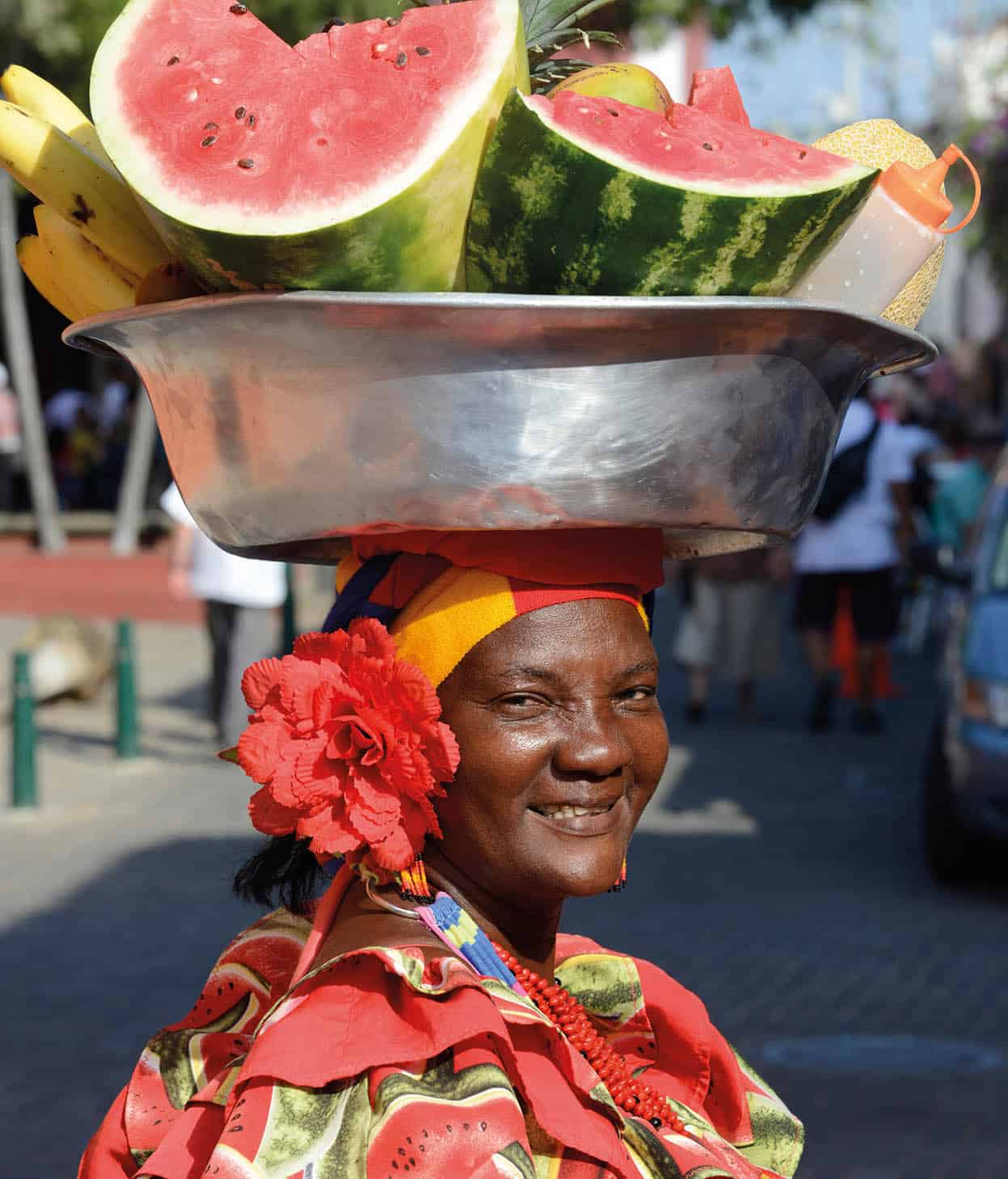
A woman in traditional dress carries fruit on her head in Cartagena.
Getty Images
This isn’t to suggest that Colombia is a segregated country, although racial tensions and prejudices do exist. The largest urban areas are melting pots where the country’s various demographics live side-by-side and often co-mingle as one. In Bogotá, for example, the population make-up is predominantly white and mestizo (those with mixed white and Native American heritage). However, there’s also a diverse cultural make-up comprised of those who migrated from Chocó, Costeños from the Caribbean region and descendants of 20th-century immigrants from Europe and the Middle East.
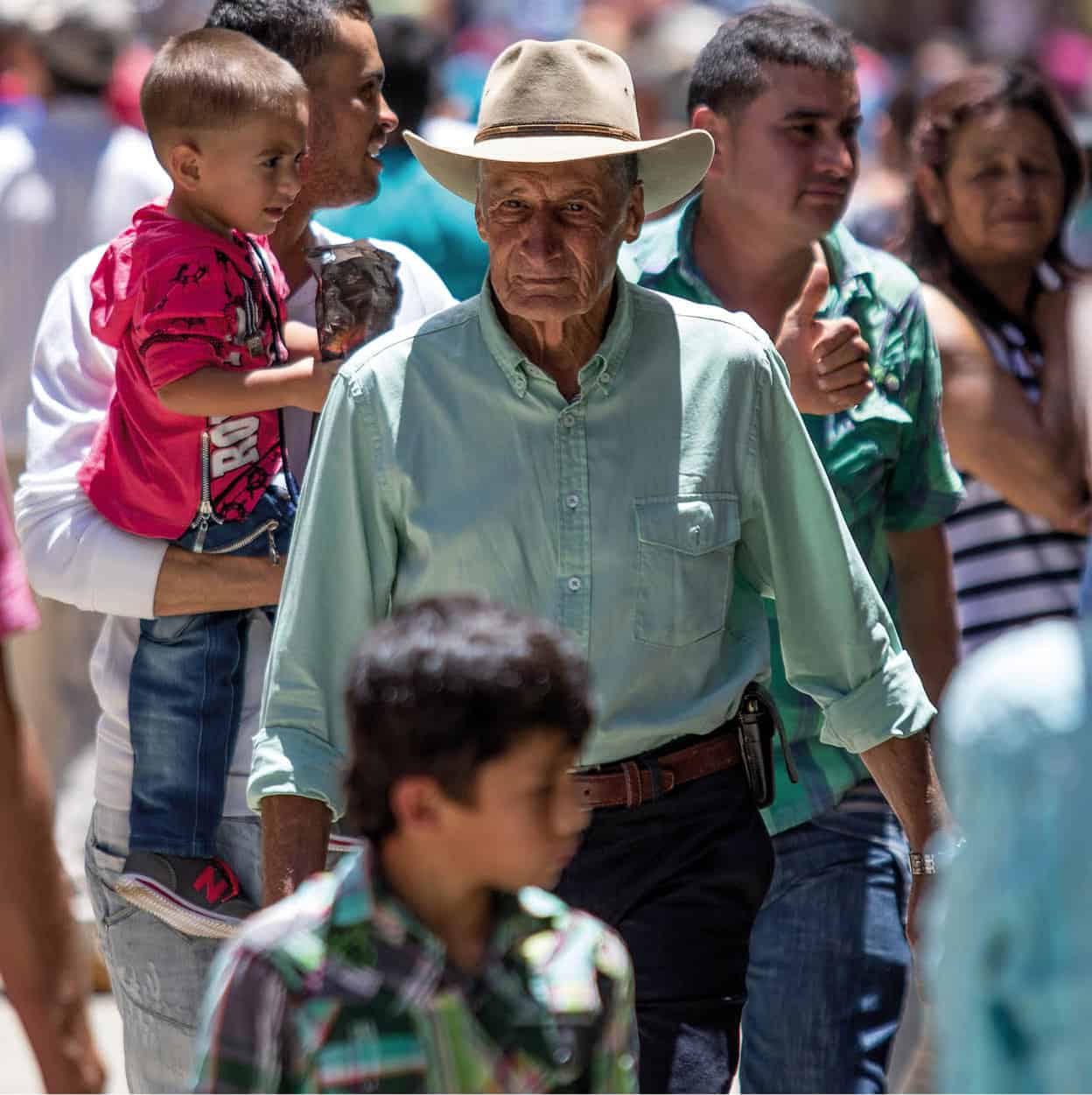
Locals in Jardín.
Shutterstock
This heritage can be traced back to the beginning of the 16th century when the Spanish conquistadors arrived, the slave ships landed in Cartagena and Panama, and the natives first set eyes on new visitors with dubious intentions. It’s no small thing that whole indigenous populations survived to this day in the face of Spanish colonialists and post-independence politicians. Its proof that, although Colombian race relations far from perfect, the country’s commitment to the preservation of their cultural and ethnic heritage is tangible.
Indigenous groups
Colombia is home to some 87 native tribes, which make up just over 3 percent of the country’s population. The total number of indigenous peoples comprising these tribes is roughly 800,000, and they occupy nearly 31 million hectares of government resguardos (reserves). These autonomous territories make up about one-third of the country’s total landmass, and can be found in virtually every corner of the country.
Despite this abundance of native groups, about 80 percent of the total indigenous population (70 tribes) live in the Cauca Department on the Guajira Peninsula. These are mostly descendants of the Wayúu people, the country’s largest indigenous group, whose number almost 150,000 in Colombia today. That said, the origins of all indigenous peoples in Colombia can be traced back to three main groups: the Quimbaya of the Cordillera Central, the Chibchas and the Kalina. The two most advanced tribes of the pre-colonial era were the Chibcha-speaking Tairona and Muisca. The Chibcha are still the largest ethno-linguistic group in the country, with around 150,000 native speakers.

Beauty queen at Wayúu Cultural Festival, Uribia.
SuperStock
Protection of indigenous culture and promotion of native rights has been a slow and sometimes frustrating process, although not one without its successes. A 1991 constitutional reform recognized indigenous rights by granting natives two senate seats and the ONIC (National Colombian Indian Organization) won a third seat that same year. However, there’s progress yet to be made, as many indigenous who reside in remoter areas, like Amazonia, are still underrepresented politically and economically. For more details, visit www.amazonteam.com.
The Wayúu are the largest indigenous group living in Colombia and they represent about 20 percent of the country’s Native American population. They live mostly on the Guajira Peninsula and adhere to time-honored traditions, such as respecting the land and promoting sustainable lifestyles.
Immigration in the 19th and 20th centuries
Colombian immigration policy under Spanish rule was restrictive, and despite loosening restrictions once the nation became a republic, the violent unrest during the middle and later half of the 20th century made Colombia a less-than-attractive destination for immigrants.
However, in the 16th century Colombia was a very attractive landing spot for Basque immigrants. Estimates place the Basque population around this time as being nearly 10 percent of the total population, with many settling in the region of Antioquia and becoming some of the first entrepreneurs in the country. A small number also arrived toward the middle of the 20th century due to the Spanish Civil War. Germans also arrived in Colombia around this time, and estimates suggest there were 10,000 Germans living in Colombia by 1941.
In 1880 Colombia saw the first wave of Syrian, Lebanese, and Palestinian immigrants arrive. They were mostly Maronite Christians but there were some Sunni Muslims as well.
People from the Middle East would continue to immigrate to the country throughout the early part of the 20th century, mostly as a result of the fallout regarding territories colonized by the Ottoman Empire. By 1945, large numbers of émigrés from the Arab-speaking world were settled in Barranquilla, Cartagena, Bogotá, and Cali, with the Sunni Muslim population settling primarily in the Maicao region. Figures place the total number of Middle-Eastern immigrants to Colombia between 40,000 and 50,000 people from 1880–1930, making them the largest immigrant group in Colombia after the Spanish.
Colombia also has a small Chinese population, mostly settled in the Cali area. Some 3,000 immigrants from North America arrived in Barranquilla in the late 19th century, and there was also an influx of African immigrants during the 19th and 20th centuries due to Colombia’s constitution offering full rights to those of African descent. As economic unrest in neighboring Venezuela continues, many Venezuelans continue to cross the border en masse and settle in the capital and border cities like Cúcuta.
Minorities and racial hierarchies
It’s difficult to glean exact figures on racial demographics in Colombia, since the national census stopped referring to race in 1818 as a way to avoid non-objective classification. They now use a more general system to classify ethnic groups. General estimates suggest Colombia is 37 percent white (European descent), 49 percent mestizo (white/ Native American descent), 10.5 percent Afro-Colombian, and 3.4 percent Indigenous. Despite no official lines of demarcation between social categories, most Colombians still identify themselves according to a few ethnic factors, including ancestry, socio-cultural status, and physical appearance. These factors often determine social interactions and define social categories – a racial hierarchy that has its roots in the colonial social system.
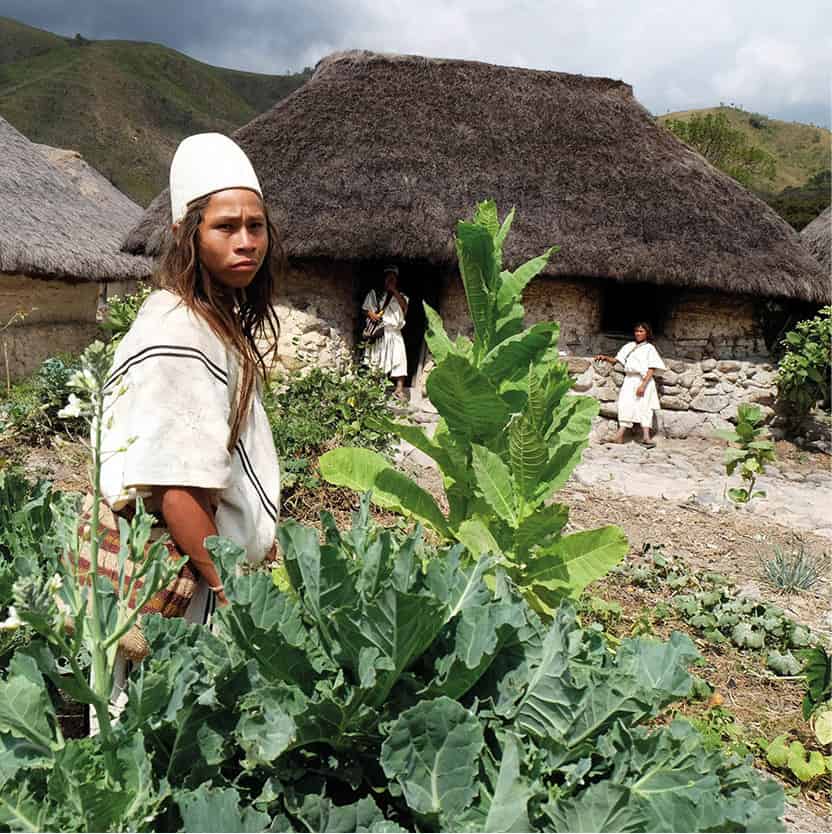
Arhuaco man in Nabusimake.
Getty Images
Various racial groups can still be found in different concentrations in Colombia, just as they were in the 16th century. The white population was mostly concentrated in large urban centers, like Bogotá, and the mestizo population emerged when Spanish conquerors entered the highland areas and mixed with the female members of indigenous tribes. For centuries the mestizo group was a peasant class, living outside urban areas, but by the 1940s they had moved into the big cities, becoming part of the working poor. Certain indigenous groups were able to survive the Spanish conquest and subsequent co-mingling due to the fact they existed in remote areas like the arid Guajira Peninsula or the inaccessible jungles of the Amazon Region. Many of these groups retained their indigenous language and still speak it today.
Still, the hierarchal society created by the Spanish in Colombia was one where white skin was synonymous with high status and brown or black skin was associated with the lower classes. Despite outnumbering whites and those of mixed blood in certain regions, Afro-Colombians and indigenous peoples had no shared identity on a national level, which further cemented their status as minorities. An example of this can be seen in the fact that, although Colombia was the first country in the Americas to grant full rights to black population post-slavery, they were still viewed as little more than slaves for years afterward and relegated to remote coastal areas.
These factors, combined with a lack of mass immigration and fervent regionalism made it easier for the Spanish to retain their traditional institutions, such as Roman Catholicism, and thus preserve their white European identity. Today there is more integration in Colombian society, particularly as historically marginalized ethnic groups continue to move into major urban centers and mix with various socioethnic classes. Still, the ugliest aspects of the old racial hierarchal system continue to exist. Indigenous tribes are still underrepresented politically, and Afro-Colombians still face economic discrimination. According to a 2005 census, 74 percent of black Colombians earn less than the minimum wage. And the Chocó, home to the majority of Afro-Colombians, is economically destitute, with little resources for education and little hope for upward mobility.
The forgotten refugees
Humanitarian crises exist throughout the world, and today there is a crisis of dire proportions in the South American country of Colombia. This is a place most outsiders now view as enjoying a peaceful renaissance, yet millions of its own citizens have been left without a home.
Colombians from the poorest parts of the country, particularly the Chocó Department, as well as campesinos from more remote areas, have been displaced by guerrilla groups. This occurs when the guerrillas move into rural areas that are attractive propositions for their remoteness and jungle cover, forcing the locals out or simply murdering them in the process. The Colombian government places the number internally displaced peoples due to this kind of conflict in the country at around 3.2 million people, while human rights groups have it much higher, at around 5 million.
Refugees within Colombia often live outside the major cities, like Bogotá, in the poorest and most unsafe environments. The crisis has spilled over into Ecuador, with thousands of asylum seekers looking to cross the border. Doctors Without Borders has labeled this tragic occurrence one of the world’s ‘forgotten crises.’ However, there are things that can be done. To find out how you can help, check out The Colombian Refugee Project (www.colombianrefugeeproject.wordpress.com) and the UN Refugee Agency (www.unhcr.org/colombia.html).
Colombian family structure
The family structure in Colombia, as with many Latin American countries, is a highly valued aspect of society. This nation is also more traditional than other modern democracies. For example, in Colombia it is not uncommon – and often it’s expected – for men and women to continue to live at home with their parents until they are married, often well into their 30s. When parents reach retirement, the responsibility then falls to the children to care for them, with the parents often living in the same house as their children and grandchildren.
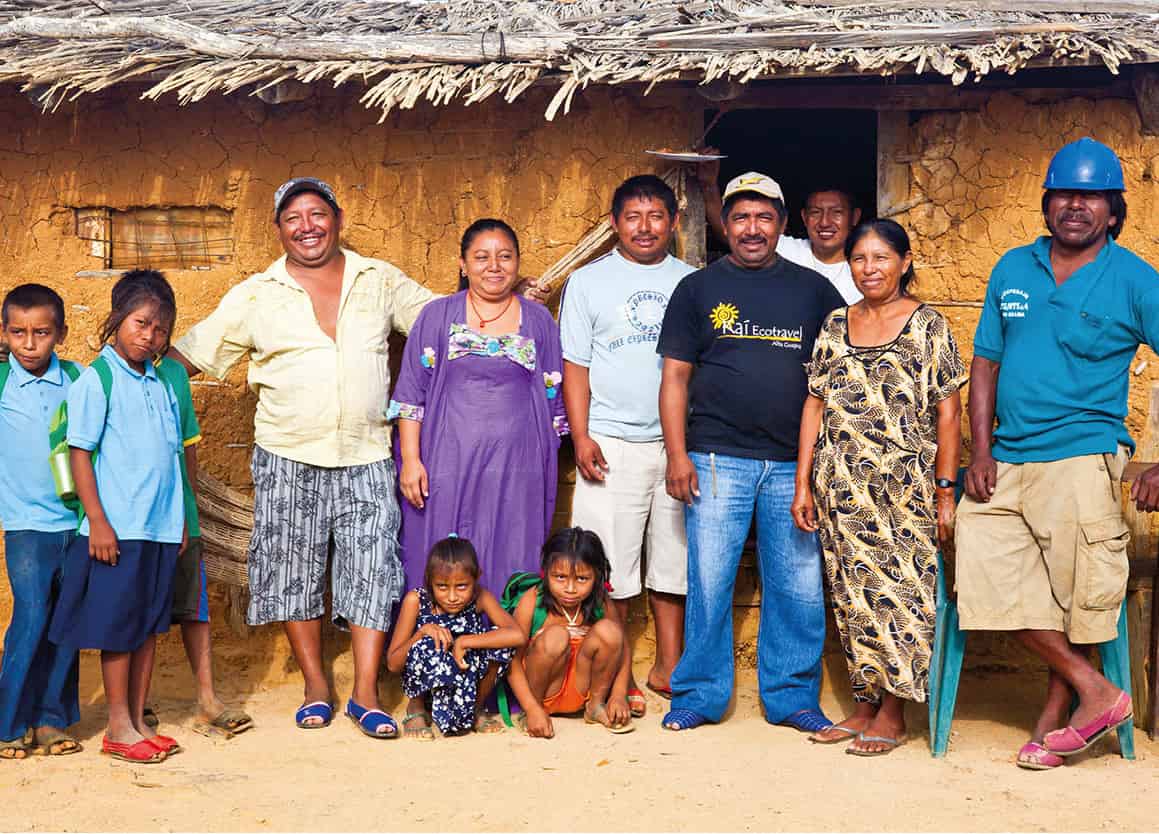
Residents of the Guajira Peninsula.
SuperStock
As for matrimony, the Roman Catholic Church, not surprisingly, plays a significant role. Weddings are often expensive, lavish affairs that take place in colonial churches. These occasions are often marked by the bride and groom taking part in the candle ceremony, where the bride and groom light two candles and then use the two flames to light a single candle, symbolizing unity. Another matrimonial tradition is the pre-wedding serenata (serenade) in which the groom-to-be surprises his lady (usually while she’s sleeping) in her family home with a few songs, usually accompanied by a live band. Liquor is ever present and the event often goes on for hours.
The post-marriage familial household is a patriarchal one, with clearly defined roles for the husband as the provider and wife as the caregiver. This dynamic is a result of tradition, but equal civil and property rights mean these roles aren’t legally defined. Women and men are free to adjust their responsibilities to the household, and as the times progress they often do, although tradition often wins out in most Colombian families. Also, in another sign of Colombia’s legal progressiveness, this traditionally Roman Catholic country legalized same-sex marriage in 2016.
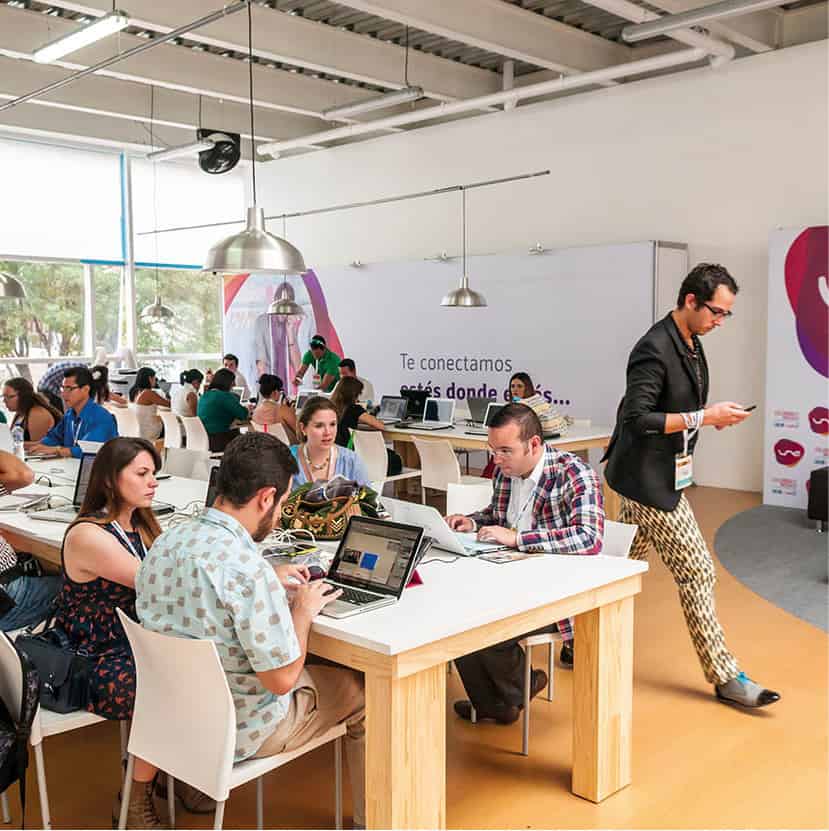
Fashion journalists in Medellín.
SuperStock
Women’s roles in Colombia
The typical household in Colombia may have patriarchal roots, but that isn’t to say the country is a cultural throwback. Women often choose to have a career, and many middle and upper-income households do indeed have dual breadwinners. Still, these two cultures – the old and the modern – do clash at times. It can lead to some head-scratching moments for first-timers to Colombia, like when you meet a 30-something woman who went to medical school to become a doctor, who’s still living at home, waiting to be married. There are still plenty of households where the man circumscribes the role of the woman, relegating her to domestic responsibilities and childbearing.
With the lower income classes it’s a different story, as tradition takes a backseat to doing what needs to get done. As with many poorer households across the globe where the father is absent, the woman assumes all roles, from sole breadwinner to head of the family, often working two or three jobs just to survive. Regardless, women throughout the country are continuing to break down barriers, entering politics (a traditionally male-dominated arena) on the local and national levels, and pushing toward the finish line for Colombia’s first-ever female president.
Poverty and rural displacement
Colombia’s classification as an Upper Middle Income country by the World Bank is something of a misnomer. Poverty and wealth disparity continue to be big problems, and are perhaps most evident in the dilapidated shanties on the outskirts of most major cities, as well as in the horse-pulled wooden carts meandering just outside the capital’s wealthiest neighborhoods.
The poverty gap disproportionally affects the most vulnerable groups in Colombia: 45 percent of the Afro-Colombians, indigenous, and campesinos (peasant farmers) live below the breadline. Principally, this is due to the fact that they live in remote rural areas desired by guerrilla groups. For instance, land seized in the Chocó, as well as violence and theft perpetrated against campesinos by these groups has led to mass displacement, forcing thousands of people out of the country and into the poorest shanty towns outside major metropolitan centers.
Still, poverty rates have dropped significantly over the years. The National Administrative Department of Statistics (DANE) put those living below the poverty line at 47 percent in 2004. By 2015, this had significantly decreased to about 28 percent. Despite these laudable gains, a true middle-class existence remains elusive for many Colombians. That’s because in 2013, DANE set the poverty line at a salary of just US$3.80 per day. And, of course, a real solution to seriously decrease poverty in Colombia will never be a reality until there is total peace between the government and the rebels.